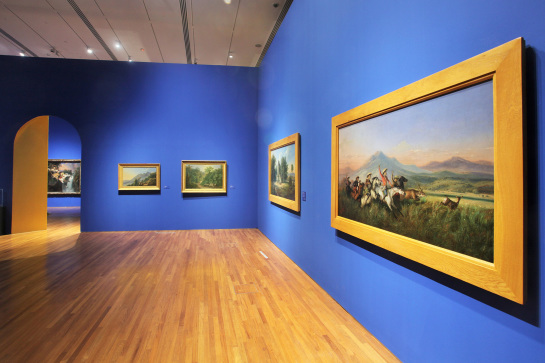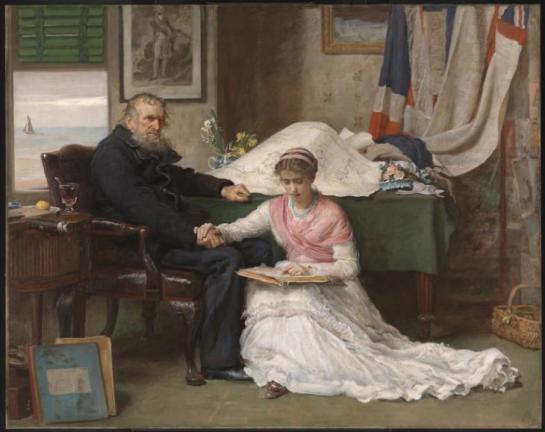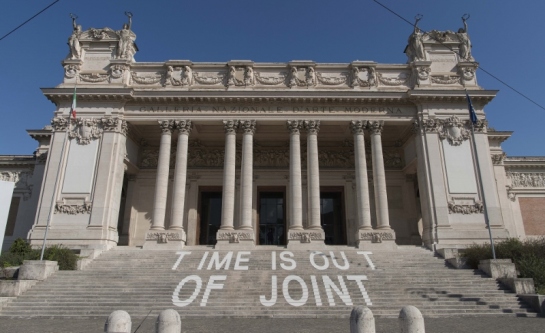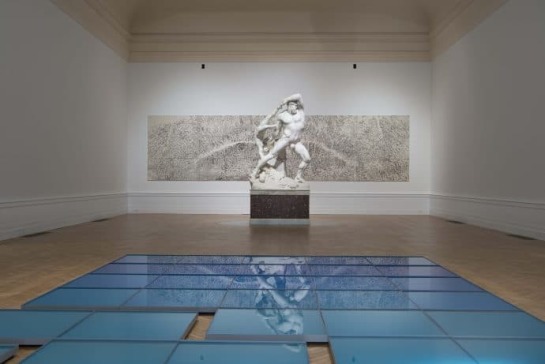THE SINGAPORE SERIES — CHAPTER 11

Meanwhile, at the National Gallery of Singapore…
When the National Gallery of Singapore finally opened its doors to the public on the 24th of November 2015 – the year of the Lion City’s 50th birthday year – it was all the rage. The crowd flowed through the majestic stairs leading to the basement ticket hall, in a space whose proportion rivalled those of the Changi Airport. They were all considering whether the building – which was much discussed for the outrageous amount of money that been spent in realising it – lived up to the expectations. There was an open call for architecture studios, and the final project was given to a French studio, Studio Milou, in the typical Singapore fashion of calling foreign talents to deliver excellence. The French design firm looked to the Musée d’Orsay when deciding to build a majestic structure, merging the historical buildings of the former Supreme Court and City Hall. But the references were actually even more varied. For the entrance hall, where the sun poured through the filigree roof, Jean-François Milou was thinking about the lace worn by an old lady perhaps, and the latest Balenciaga collection, guessing the Singaporeans’ soft spot for luxury goods.
And it actually looked pretty good. Every floor was a surprise: passing a bridge connecting the two buildings, you got to an interior terrace where the dome of the Supreme Court, now a library, poked out of the floor. Furthermore, the difference in the buildings’ heights had created another terrace on top of City Hall, called Padang Deck and Sky Lounge where restaurants were located (to quote Banksy, the exit is always through the gift shop, right?). The architecture was already telling of a way of operating which didn’t try to invent anything, but was rather following a blueprint for success – making it as majestic as possible. It was an evident embodiment of Singaporeans’ obsessions with being “world class”. Also the way art was selected and exhibited followed the traditional Western scheme for cataloguing, showcasing and archiving art, but declined in the local context. Instead of buying in Old Masters or Impressionists – a wise decision – they found their own masters and tried to look to the progression of local art history. Indeed, the two main galleries hold permanent collections of Singaporean and south-east Asian art up to the late 20th century, in what had been defined as, “The world’s leading public collection of modern art from Singapore and Southeast Asia.”

The main exhibition ‘?’ (“What Is Your Name?” in Malay), explored Singapore’s identity. The local art history was divided into six periods – Tropical Tapestry, Nanyang Reverie, Real Concerns, New Languages, Tradition Unfettered and Shifting Grounds. Through the work of masters like Cheong Soo Pieng, Chen Chong Swee, Anthony Poon and Thomas Yeo, visitors were able to see how Singaporean artists have explored their current values and ideas, while also experimenting with their craft.
On the other hand, with the second exhibition “Between Declarations and Dreams”, hosted by the UOB Southeast Asia Gallery section, the National Gallery traced the development of modern art in the region. Starting in the 19th century, the exhibition showed how the history of Southeast Asian art was inextricably connected to the region’s tumultuous social and political past. There you could also observe Southeast Asian artists’ take on international tendencies, and their relationship with local aesthetic traditions. Each chronological section of the show had an overarching theme, corresponding to the zeitgeist shared by artists from the region: Authority and Anxiety, Imagining Country and Self, Manifesting the Nation, and Redefining Art. This encompassing stare on Southeast Asia as a whole was definitely the most important achievement of the National Gallery. Prior to that, modern and contemporary art from the region was separately stored in archives and private collections. It was discussed by arts writers and critics, but never cohesively and publically displayed. Interesting questions arise: how did nationalistic impulses emerge from the works of different regions? What relationship did the artists have with the modernists styles from the West? Was there ever an artistic dialogue across Southeast Asia? These reflections, previously tackled only by academics and specific art history courses, will now be available to a general public.
The contemporary art section was still quite small for the time being. It hosts a few key works marking the recent developments of contemporary art in Southeast Asia. Here the social and the political are still protagonists. The status quo is challenged in the works of local artists such as Amanda Heng and Tang Da Wu, and in the media experimentation of pioneers like Indonesian Krisna Murti.
Visiting the NGS at intervals, I could see that it was doing a great job at putting up exhibitions with very timely topics relevant in the local context. A show I enjoyed was Titled “Between Worlds: Raden Saleh and Juan Luna,” the new exhibition at the National Gallery Singapore curated by Clarissa Chikiamco, Syed Muhammad Hafiz and Russell Storer. The show presented the audience with masterpieces by the Indonesian and Filipino masters, exploring each of the artists’ works over their illustrious careers across different time periods. Raden Saleh and Juan Luna are two of the earliest and most significant modern artists in Southeast Asia. By observing the masterpieces, one can see similarities and differences in terms of European influences, attitudes of the artists and the two countries towards colonialism, nationalistic aspirations and orientalism. Indeed, despite coming from different countries and being active at different times in the 19th century, the two shared a similar journey as Southeast Asian artists who sailed across the ocean to hone their craft in Europe, earned their place within European art worlds and achieved successes in their home countries. Raden Saleh, who received the title of King’s Painter by King Willem III of the Netherlands, was the first Indonesian artist to receive training in Europe. He refined his skills in the Netherlands before going on to receive acclaim in Germany and Paris for his signature Orientalist animal hunts and fights. Luna, taught by Spanish painter Alejo Vera, studied in Madrid and Rome. His painting, Spoliarium, earned him fame in Spain and won him the first-class medal in Spain’s annual art exhibition in Madrid in 1884. He later moved to Paris, taking part in the salons while exhibiting and accepting his commissions in Spain.

In 2017, I particularly appreciated “Artist and Empire: (En)countering Colonial Legacies”, which presented works from international and regional collections as well as Singaporean institutions, from the 16th century to the present day. The show was a local repurpose of the original show at Tate Britain, exploring the different ways in which the British Empire has been represented and contested through art. It critically examines art produced for the British Empire from a contemporary perspective, and most importantly for a Western visitor like me, it featured viewpoints from Southeast Asia, specifically Singaporeans. Indeed, the exhibition specifically looked at the figure of Sir Stamford Raffles.
Of course, in this book I’m mostly looking at the structure of the Singaporean art system, so when I say that I loved a show, what I mean that it excited me in proving further pointers confirming a very specific attitude coming from Singapore. Looking beyond the work, observing critically the framework of the show and reading between the lines, are all necessary elements if you want to have a more thorough vision of the attitudes of the Singaporean art system. Here, the lack of rage for the colonial usurpation – which I had already discussed with Donna Ong in our interview – emerged clear. As academic, arts and cultural manager Venka Purushothaman wrote it in an article called “Socialising with the Colonial”, for the magazine Third Text , the show “Artist and Empire” highlighted a complicity of exhibition-making, which inadvertently normalised colonialism, rather than looking at it critically. In the article, the writer suggested that socialising with the colonial has become central to nation-states’ survival and independence as they struggle to provide for their fast rising and aspiring communities.

Indeed, polemics as well as healthy criticism and discussion have surrounded the National Gallery and its vision and aim since it was first announced. Singapore had been accused of appointing itself as an art arbiter for the region. Some felt other countries should have hosted a museum of this kind. But as government funding goes, Singapore is at present the only country in the region heavily investing in infrastructure. Furthermore, no other country has stepped forward to propose a viable alternative. One of the main reasons as to why Singapore called upon itself to become the container, the super partes judge for the art history of the entire region, it is because it had the money to do it. However, as things are at present, it is really the only super partes place, the city port where cultures are acknowledges, but the one that doesn’t hold to a specific cultural characterisation, and keeps an international look. The investment in the National Gallery of Singapore certainly helped in positioning Singapore as an arts hub for the region. This building exemplifies the attitude of Singapore toward the region and perhaps the world.
So, with all the ego-driven showcase of luxury, I’m actually convinced that this has been a very important endeavour for Singapore and the whole region. What is displayed here will set the parameters for art history in South East Asia for the times to come. Until now, there was no one place where the art history of Southeast Asia was put together; although private museums with their collections are popping up in Indonesia and Thailand, they still can’t rival the government-funded institution. In the state of affairs today, text books are lacking, and reaching a unitary art history in dialogue, or as a continuation (this is up for discussion to) with Western art history is mandatory to set the parameters for quality in the art system. Crucially, the NGS will provide local bourgeoning artists models and shoulders to stand on. It will possibly inspire them to look beyond the market and ephemeral trends. The new museum is inevitably educating the general public, while reconstructing a collective memory for the region.
NGS versus the New Gnam
While the East finds its security in category, perhaps fighting its insecurity to legitimise itself and enters the “international contemporary art club”, the West is doing quite the opposite. Stuffed and stifled by too many categories, it is trying to free itself by destroying them and becoming more and more fluid. Exactly one year after the opening of the National gallery of Singapore, after returning from a trip from Singapore, I visited the GNAM, Galleria Nazionale Arte Moderna. Or should I call it Galleria Nazionale, as it was rebranded. For those ex-art academy students like myself, waking in the immaculate space, where all the wood boiserie, the tinsel and decorations have been whipped out by a neutral, international look of an immaculate candour, it was quite startling. Even more startling was the abolition of the distinction between modern and contemporary art, or of any philological set-up, as it was designed by the previous Superintendent Sandra Pinto.

The permanent exhibition, aptly called “Out of Joint” from someone who probably smoked one too many – that was harsh, but so was it this polarsing operation, brought together 500 works of 170 artists, which the curators have not arranged by thematic or chronological criteria, but simply by colour schemes, evocations, symmetrical schemes. Above all visuals cues, sometimes quite refined, other times obvious, and in the last few rooms, as if they would have run out of patience, in a totally chaotic way. The modern point that I must recognise in relation to the exhibit, is that it is based on the very modern idea of relationship, as each work defines itself in the interaction with the others. This is something that must be preserved and taken as a cue. In her words, the director wanted to create “new unexpected relationships in the symbolic space of the museum”. And that is perhaps the most telling quote which speaks volumes about the radically different places Rome and Singapore are coming from.

From Rome, the museum structure is now reduced to a symbol. Nothing concrete, nothing useful, assuming that art history would come to his population by other means. In times of fluidity of art, also the containers are becoming fluid, causing in my opinion a lot of confusion. Don’t get me wrong, I’m always good with experiments, with mixing up high brow and low brow. But please don’t do it with the actual Hercules of Canova. Don’t tuck a fundamental masterpiece of Italian art such as The Sun by Giuseppe Pellizza da Volpedo into a corner near a photograph of the contemporary artist Adrian Paci. I’m good with postmodernism, but I don’t feel this means everything should be just superficial, aesthetic, fleeting. In these fluid times, in a position as important as the director of a National gallery, you get out of the postmodernism impasse with your charisma – which doesn’t mean always and forever a superficial, ironic detachment, but having the courage to state your values. This can also be the opposite of conservatorism – you can also think Canova and Pellizza da Volpedo are not important to you – but then tell us what is important to you. Past directors such as Palma Bucarelli who dared to introduce contemporary art which looked nonsensical back then, had the courage to do that, and so we remember her as a contemporary art heroine. However, in the new GNAM, I see this art of courage as lacking. I see a director who sensed something, did something, but didn’t finish the job. And perhaps this is the greatest impasse part of the Western art world is falling into. What I hope in the future is that exchanges between their Eastern counterparts – who are on the contrary holding onto rigid categories – could cross-pollinate and create a more balanced and harmonious way of looking at art. Perhaps one more fitting for these times, with the force of producing thought and introspection in the face of forces of the market. As opposing to the stuffy, last century museums, or the chaotic contemporary ones – a lively space where the spirit can live and express.



